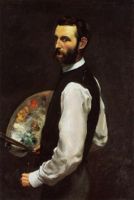Difference between revisions of "Palette"
(Created page with 'File:lighterstill.jpgright|frame ==Origin== French, from Middle French, diminutive of ''pale spade'', from Latin ''pala''; probab...') |
m (Text replacement - "http://" to "https://") |
||
| (One intermediate revision by one other user not shown) | |||
| Line 3: | Line 3: | ||
==Origin== | ==Origin== | ||
French, from Middle French, diminutive of ''pale spade'', from [[Latin]] ''pala''; probably akin to Latin ''pangere'' to fix | French, from Middle French, diminutive of ''pale spade'', from [[Latin]] ''pala''; probably akin to Latin ''pangere'' to fix | ||
| − | *[ | + | *[https://en.wikipedia.org/wiki/17th_century 1622] |
==Definitions== | ==Definitions== | ||
*1: a thin oval or rectangular board or tablet that a painter holds and mixes pigments on | *1: a thin oval or rectangular board or tablet that a painter holds and mixes pigments on | ||
| Line 10: | Line 10: | ||
A '''palette''' in the original sense of the word, is a rigid, flat [[surface]] on which a painter arranges and mixes paints. A palette is usually made of wood, plastic, ceramic, or other hard, inert, nonporous material, and can vary greatly in size and [[shape]]. The most commonly known type of painter's palette is made of a thin wood board designed to be held in the artist's hand and rest on the artist's arm. Watercolor palettes are generally made of plastic or porcelain with rectangular or [[wheel]] format with built in wells and mixing areas for [[colors]]. | A '''palette''' in the original sense of the word, is a rigid, flat [[surface]] on which a painter arranges and mixes paints. A palette is usually made of wood, plastic, ceramic, or other hard, inert, nonporous material, and can vary greatly in size and [[shape]]. The most commonly known type of painter's palette is made of a thin wood board designed to be held in the artist's hand and rest on the artist's arm. Watercolor palettes are generally made of plastic or porcelain with rectangular or [[wheel]] format with built in wells and mixing areas for [[colors]]. | ||
| − | From the original, [[literal]] sense above came a figurative sense by extension, referring to a selection of [[colors]], as used in a specific art object or in a group of works comprising a visual [[style]]. This second, figurative sense is the one extended in the digital era to [ | + | From the original, [[literal]] sense above came a figurative sense by extension, referring to a selection of [[colors]], as used in a specific art object or in a group of works comprising a visual [[style]]. This second, figurative sense is the one extended in the digital era to [https://en.wikipedia.org/wiki/Palette_(computing) the computing senses of "palette"]. |
| + | |||
| + | [[Category: The Arts]] | ||
Latest revision as of 01:21, 13 December 2020
Origin
French, from Middle French, diminutive of pale spade, from Latin pala; probably akin to Latin pangere to fix
Definitions
- 1: a thin oval or rectangular board or tablet that a painter holds and mixes pigments on
- 2: a particular range, quality, or use of color: a comparable range, quality, or use of available elements <a rich palette of tones and timbres> <a palette of flavors>
Description
A palette in the original sense of the word, is a rigid, flat surface on which a painter arranges and mixes paints. A palette is usually made of wood, plastic, ceramic, or other hard, inert, nonporous material, and can vary greatly in size and shape. The most commonly known type of painter's palette is made of a thin wood board designed to be held in the artist's hand and rest on the artist's arm. Watercolor palettes are generally made of plastic or porcelain with rectangular or wheel format with built in wells and mixing areas for colors.
From the original, literal sense above came a figurative sense by extension, referring to a selection of colors, as used in a specific art object or in a group of works comprising a visual style. This second, figurative sense is the one extended in the digital era to the computing senses of "palette".
